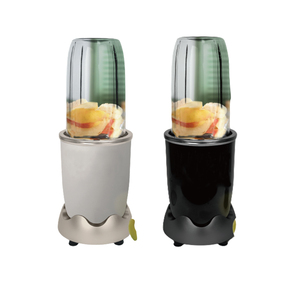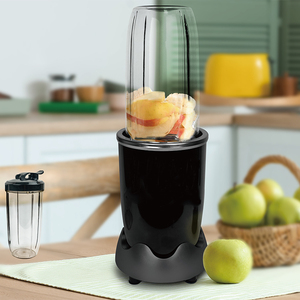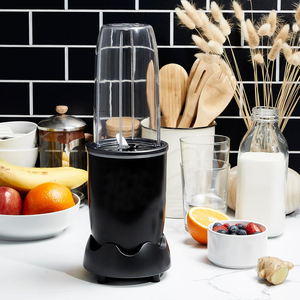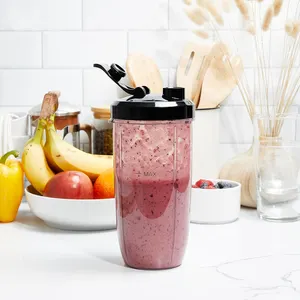
All categories
Featured selections
Trade Assurance
Buyer Central
Help Center
Get the app
Become a supplier

(3500 products available)














































Whether for home or commercial use, blender jugs come in various types to suit different needs and preferences. Here are some of the commonly used blender jugs:
Plastic Blender Jugs
Blender jugs made from plastic are lightweight and virtually unbreakable. They are less likely to crack or break if dropped. However, plastic jugs may scratch and dent more easily than glass or stainless steel. In addition, the jugs can retain odors and stains from highly flavored or colored food. But since they are less likely to crack if dropped, they are usually used by some manufacturers to make blender jugs. Some plastic jugs are dishwasher-safe, while others are not. If not dishwasher safe, plastic jugs should be hand-washed with a soft sponge and non-abrasive dish detergent to prevent scratching.
Glass Blender Jugs
Glass blender jugs are more durable than plastic jugs. They don't scratch or dent easily from regular use and stay looking new for longer. Glass jugs are also resistant to odor and stain retention, so they won't hold onto smells or develop discoloration from strongly flavored or brightly colored food. Their weight makes them more durable, but glass jugs are more likely to crack or break if dropped. They are also safer to use as they don't release harmful chemicals into food when heated. Glass blender jugs are usually dishwasher-safe, making washing them easy and less demanding.
Steel Blender Jugs
Chef's call steel blender jugs (stainless steel) highly durable and unbreakable. They can handle rough commercial use without denting or losing appeal. The metal material means steel jugs won't crack, break, or shatter if dropped. Steel jugs also last a long time because they don't scratch, dent, or get worn out easily. Using steel jugs eliminates the worry of plastic releasing harmful chemicals when blending hot food, so safer plastic-free cooking is possible. Stainless steel blender jugs keep food cold or hot for longer since they are insulated. However, stainless steel blender jugs are usually not see-through, so watching the blending progress is difficult. Steel jugs also cost more than plastic or glass options. Steel blender jug is usually not compatible with dishwashers. They should be hand-washed with non-abrasive dish detergent to avoid scratching and retain their shine.
Blender jugs help produce blended food items conveniently. The following table summarizes common features and their functions;
Material
Blender jugs are made using several materials. These can be plastic, glass, or stainless steel. Usually, the material has a major influence on factors such as durability, weight, and heat retention. Plastic jugs are lightweight and shatterproof, while glass jugs have better heat retention and are more hygienic. Generally, a wide variety of materials cater to various customer preferences.
Handle
Most blender jugs have ergonomic handles. They allow users to pour the blend with comfort and ease. This reduces hand and wrist strain when carrying the jug. Moreover, the handles are strategically placed so that users can pour contents without spilling them.
Graduated Measurements
Many jugs have measurement markings. These markings help users measure ingredients accurately. As a result, users can achieve precise measurements without using a separate measuring cup. Accurate measurements enhance the quality of the blended food since different recipes require varying proportions of ingredients.
Secure Lid
Blender jugs have secure fitted lids. The lids prevent splatter and leakage when blending. They keep the kitchen counter clean and reduce the risk of burns or cuts from hot liquids. In addition to this, the lids allow users to blend hot liquids safely. They create steam vents that reduce pressure buildup during blending.
Spout
Most jugs have spouts. They allow for easy and precise pouring. The spouts minimize the risk of spilling, which helps in transferring blended contents without making a mess.
Dome Base Design
Dome-shaped jugs are more efficient than straight-sided jugs. They create a vortex that pulls the ingredients towards the blades for better mixing. The enhanced vortex results in faster and more consistent blending.
Volume Capacity
Blender jugs come in different sizes. The variety of sizes available ensures that there is a jug for every need. Whether users are blending small or large amounts, there is a jug that can handle the task. The capacity ranges from 0.5 liters to 3 liters.
Jugs for blenders are useful for home cooking and professional culinary tasks. Here are some typical usage scenarios:
Restaurants and Cafes
Blender jugs help chefs and baristas to prepare numerous meals and drinks quickly. They are used for making smoothies, pureeing soups, preparing sauces, and mixing batters. High-volume jugs are suitable for busy eateries because they can serve many guests in a short time.
Cooking in Large Quantities
Professional kitchens that cater to events and institutions use large-capacity blenders to cook in large quantities. Blender jugs with large capacities help to prepare meals for several guests at once. Such jugs are useful for making mashed potatoes, sauces, or soups when feeding large groups.
Food Processing
Blender jugs are essential for kitchens that offer food processing services. The jugs can chop vegetables, grind meat, and make dough smoothly. These jugs help food processors to work faster and offer quality service to their clients.
Catering Services
Catering specialists use blender jugs for transport and to mix and emulsify dressings, marinades, or cocktail bases on location. Chef's blender jugs with secure lids are suitable for carrying liquids and preventing spills during transportation.
Testing and Product Development in Food Processing Companies
Blender jugs are useful for testing new recipes and perfecting them before mass production. Food scientists use blender jugs to replicate different food textures and tastes while creating and testing new snacks, sauces, soups, and drinks.
Smoothie and Juice Bars
Many smoothie and juice bars depend on blender jugs to crush ice, blend fruits, and make smoothies and juices. These jugs help workers produce different drink textures and understand customer preferences.
Health and Wellness Centers
Blender jugs help nutritionists and dietitians prepare demonstration meals, shakes, and smoothies for health and wellness programs. These jugs can blend a wide range of ingredients to educate clients about balanced meals.
When purchasing blender jugs, it is essential to understand the needs of the target customers. Different customers have different preferences when it comes to materials and design. Here are some factors to consider when choosing blender jugs for sale.
Q: Are blender jugs microwave safe?
A: No, microwave safeness of jug depends on the material. For instance, the glass and stainless steel jugs are generally safe to use in the microwave and can withstand high temperatures but check the manufacturer's guidelines. As for plastic blender jugs, they are not microwave-safe because, under high temperatures, they can melt and release harmful chemicals that could get people sick if they contaminate the food.
Q: Can I purchase replacement blender jugs?
A: Yes, many manufacturers sell replacement jugs for blenders in case the customers misplace or break them. Make sure to purchase the jug that's compatible with the specific brand and model used. Also, check the manufacturer's guidelines for proper care and maintenance to ensure the jug lasts longer.
Q: How to clean blender jugs?
A: Cleaning the blender jug is pretty simple and straightforward. First, add some warm, soapy water and a drop of dish soap into the jug. Give it a good swirl using a sponge. Rinse with water and let it air dry. For tougher stains or odors, customers can soak the jug with baking soda or vinegar for a couple of minutes, then wash it off with warm soapy water. Keep in mind that most blender jugs are dishwasher safe. However, check the manufacturer's instructions to avoid damage.
Q: Are blender jugs dishwasher safe?
A: Most blender jugs are dishwasher safe for easy cleaning. However, it depends on the material. For example, plastic jugs are usually not recommended for dishwashers because the high heat can warp and affect the quality of the jug. On the other hand, glass and stainless steel jugs are safe to use in dishwashers, but they might get extremely hot due to the dishwasher's drying cycle. They also post a risk of cuts and injuries if not handled with care because people don't expect the cleaned items to be sharp.